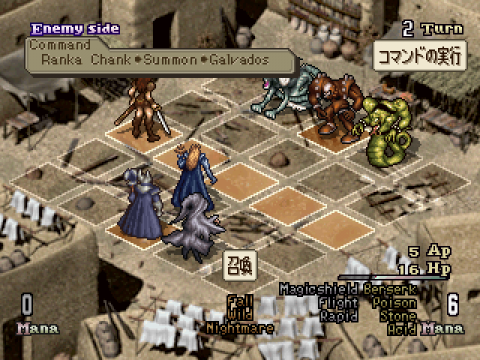Shadows of the Tusk
Developer: Hudson
Release Date: 1998
Platforms: Saturn
This article is part of our Japanese Obscurities feature. We put out a whole book about them, which is available as both a full color hardcover and a Kindle ebook from Amazon! If you’d like to see more of these features, please check out the book and if you enjoyed it, leave a five star review so we can do a follow up with even more interesting, offbeat, or historically important Japanese games!
While multiplayer online gaming didn’t really hit the mainstream until the Microsoft Xbox, Sega’s platforms were attempting it as early as the Genesis, using a modem called the X-Band. This concept was carried forward to the Saturn, with a few games that supported it, including the mecha fighter Virtual On and the chaotic explode-em-up Saturn Bomberman. One of the more unusual titles was Shadows of the Tusk, a deck-building SRPG from Hudson.
The premise of the game is that you build a “deck” that features “cards”, which is a stand in for a unique playable unit. You then take that deck into turn-based tactical combat, which plays out on a 5×5 grid, with the ultimate goal being to take out your opponent’s leader unit. In addition to beating up the opposing squad, you’ll also need to manage your MP, which is used to both cast magic spells and summon new units onto the playing field. This typically involves inhabiting certain squares, or having specific characters in combat. Inflicting status ailments is just as important as well. Since the playing field is small, matches are over pretty quickly, which runs contrast to the larger scale combat found in other games like Final Fantasy Tactics or Front Mission.
There is a short single-player story mode that’s only eight stages long and can be beaten in an hour or two, as well as an “ante” mode, where you play the computer to gain extra character cards that aren’t available on the other mode. However, the central feature of Shadows of the Tusk was meant to be that you could play live opponents online, and potentially steal their cards as well. This feature is more or less useless nowadays, though there is local multiplayer if you’d like to challenge someone face-to-face. One of the major boons of the title is that the menus are almost entirely in English, making it fairly easy for importers to play. While the story is in Japanese, it’s so short as to be inconsequential. Indeed, the concept behind Shadows of the Tusk is great, but removed from its intended online purpose, it feels pretty bare.
The character designs are by Susumu Matsushita, the illustrator famous his cover artwork work on Famitsu magazine. The blurry CG rendered sprites in the combat scenes don’t really capture his style effectively, which is a shame, because it’s uncommon to see a heavy metal fantasy – gigantic armored dudes with swords, ladies in bikini armor! – done by Japanese company. Perhaps realizing this, the game comes packaged with over 30 cards that show the original renditions of the artwork.


